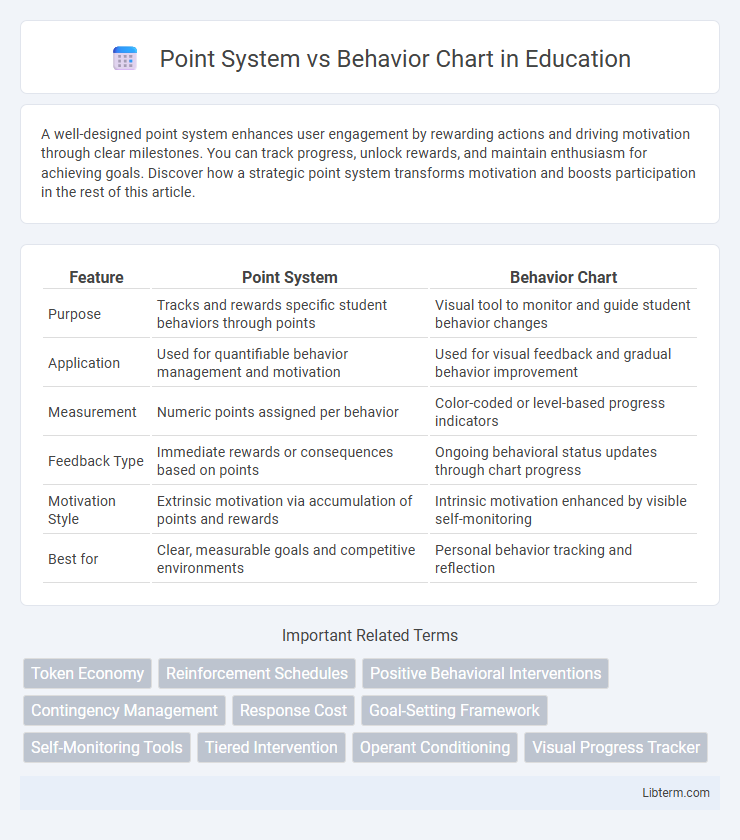A well-designed point system enhances user engagement by rewarding actions and driving motivation through clear milestones. You can track progress, unlock rewards, and maintain enthusiasm for achieving goals. Discover how a strategic point system transforms motivation and boosts participation in the rest of this article.
Table of Comparison
| Feature | Point System | Behavior Chart |
|---|---|---|
| Purpose | Tracks and rewards specific student behaviors through points | Visual tool to monitor and guide student behavior changes |
| Application | Used for quantifiable behavior management and motivation | Used for visual feedback and gradual behavior improvement |
| Measurement | Numeric points assigned per behavior | Color-coded or level-based progress indicators |
| Feedback Type | Immediate rewards or consequences based on points | Ongoing behavioral status updates through chart progress |
| Motivation Style | Extrinsic motivation via accumulation of points and rewards | Intrinsic motivation enhanced by visible self-monitoring |
| Best for | Clear, measurable goals and competitive environments | Personal behavior tracking and reflection |
Understanding Point Systems in Classroom Management
Point systems in classroom management assign quantifiable scores to student behaviors, providing clear feedback and motivating positive actions through rewards or consequences. Unlike behavior charts that visually track behavior, point systems offer a structured method to monitor progress, set goals, and reinforce consistent performance over time. This approach enhances accountability by quantifying behavior, enabling teachers to tailor interventions and track improvements accurately.
Key Features of Behavior Charts
Behavior charts are visual tools designed to track and reinforce specific behaviors through clear, immediate feedback, often utilizing symbols or colors to indicate success or areas for improvement. Key features include the ability to set targeted behavioral goals, real-time progress tracking, and the use of positive reinforcement to motivate children consistently. These charts help establish routine accountability and can be customized to suit individual needs and developmental stages.
How Point Systems Motivate Student Behavior
Point systems motivate student behavior by providing immediate, tangible rewards that reinforce positive actions, enhancing engagement and accountability. By quantifying achievements, these systems help students track their progress, fostering intrinsic motivation through goal-setting and self-monitoring. This structured feedback loop encourages consistent positive behavior, improving classroom management and academic performance.
Pros and Cons of Behavior Charts
Behavior charts provide a visual and tangible way to track and reinforce positive behavior, making them highly effective for young children who respond well to immediate feedback. However, they can sometimes cause feelings of shame or competition among peers if not implemented sensitively, potentially leading to negative emotional impacts. Unlike point systems, behavior charts often lack flexibility for complex behaviors and may not adequately motivate older children or those with different learning styles.
Customization and Flexibility: Point Systems vs. Behavior Charts
Point systems offer extensive customization by allowing educators to assign different values to specific behaviors, enabling precise reinforcement tailored to individual student needs. Behavior charts provide visual flexibility with easily adjustable goals and tracking methods, supporting diverse classroom dynamics and student progress. Both tools can be adapted to various learning environments, but point systems typically facilitate more granular feedback and motivation through quantifiable rewards.
Impact on Student Engagement and Accountability
The Point System enhances student engagement by providing immediate, quantifiable rewards that motivate positive behavior, fostering a sense of accountability through clear, measurable goals. Behavior Charts track progress visually over time, promoting self-regulation and allowing students to see their growth, which boosts ongoing commitment and responsibility. Combining these tools can maximize engagement and accountability by balancing instant reinforcement with long-term behavior tracking.
Addressing Individual vs. Group Behaviors
The point system targets individual behaviors by assigning specific rewards or consequences based on personal performance, fostering accountability and motivation tailored to each student. In contrast, behavior charts often address group behaviors, promoting collective responsibility and encouraging positive social interactions within a classroom setting. Combining both methods can effectively balance personal incentives with community-wide behavioral goals.
Tracking Progress: Data and Documentation
A point system provides quantitative data by assigning numerical values to specific behaviors, enabling precise tracking of progress over time through charts or spreadsheets. Behavior charts offer visual documentation, often using symbols or colors, to represent behavioral occurrences, making trends easily recognizable at a glance. Combining both methods enhances data accuracy and facilitates comprehensive progress analysis for effective behavior management.
Teacher and Student Perspectives
Teachers benefit from the point system by tracking student progress quantitatively, enabling objective reinforcement of positive behaviors, while behavior charts offer visual feedback that simplifies monitoring and encourages student self-regulation. Students respond well to point systems as they provide clear goals and tangible rewards, fostering motivation through measurable achievements, whereas behavior charts promote immediate awareness of behavior patterns and support habit formation through daily reflection. Both tools serve distinct roles in classroom management, with teachers leveraging data for consistent discipline and students using visual cues to internalize behavioral expectations.
Choosing the Right Approach for Your Classroom
Choosing the right approach for your classroom depends on understanding the differences between the Point System and Behavior Chart methods. The Point System offers quantifiable rewards that motivate students through clear, measurable goals, ideal for classrooms seeking structured reinforcement. Behavior Charts provide visual tracking of student conduct, promoting self-awareness and consistent behavior, making them suitable for environments focusing on long-term habit formation.
Point System Infographic

 libterm.com
libterm.com